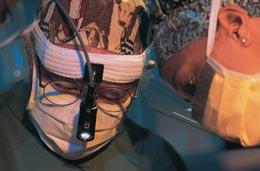Prostate Cancer
Personalized Care from Expert Urologists
About Prostrate Cancer
 Prostate cancer is the most common non-skin cancer among American men. About one in six American men will be faced with the diagnosis of prostate cancer during their lifetime. UC Davis Health provides multidisciplinary care for men with all stages of prostate cancer. Our prostate cancer program has an internationally respected team of urologic oncologists, backed by more than 25 research scientists and able to access a large clinical trials network. For men with prostate cancer, this combination means opportunities for the latest treatment advances, early diagnostic approaches and prevention strategies that may not be readily available elsewhere.
Prostate cancer is the most common non-skin cancer among American men. About one in six American men will be faced with the diagnosis of prostate cancer during their lifetime. UC Davis Health provides multidisciplinary care for men with all stages of prostate cancer. Our prostate cancer program has an internationally respected team of urologic oncologists, backed by more than 25 research scientists and able to access a large clinical trials network. For men with prostate cancer, this combination means opportunities for the latest treatment advances, early diagnostic approaches and prevention strategies that may not be readily available elsewhere.
Prostate Exams and Evaluating Your Risk
Knowing when to get a prostate exam is an important step in protecting your health. In addition, learning what the Prostate-Specific Antigen (PSA) test measures and how results are interpreted can help you understand your prostate cancer risk and when to follow up with a doctor.
Who should have a prostate exam?
- The American Urological Association recommends getting a baseline PSA test, along with a physical exam of the prostate known as a digital rectal exam (DRE), at age 40 to check for bumps and other abnormalities
- Men with a family history of prostate cancer, such as a father or brother, are encouraged to get screened
The Prostate-Specific Antigen (PSA) test
- PSA is an enzyme produced by the prostate gland that may enter the bloodstream. Men with prostate cancer often have elevated levels of serum PSA, which correlate with the extent of cancer spread.
- Normal PSA values are less than 3.0 ng/ml
- Repeated PSA values greater than 3.0 ng/ml should be evaluated by a urologist
- Normal levels can vary with age, so what is abnormal at 40 may well be normal at 70
Learn more about prostrate cancer »
Treatment Options at UC Davis Health

Treatments for prostate cancer depend on several factors, including how quickly the cancer is growing, whether it has spread and your age and overall health. By carefully weighing the benefits and potential side effects, you and your physician work together to create a personalized care plan.
The primary goal of therapy is to cure prostate cancer while preserving quality of life. The Department of Urologic Surgery places special emphasis on preventing and treating erectile dysfunction, an important aspect of care for many men. Since every case is unique, a thorough discussion with your UC Davis Health urologist and other cancer specialists can help clarify the risks and benefits of different tests and treatment options.
Treatment options include:
- Surgery — radical prostatectomy for localized disease
- Robotic prostatectomy — a minimally invasive, laparoscopic approach
- Radiation therapy — external beam radiation or brachytherapy for localized disease
- Hormone therapy — used to treat metastatic disease (cancer that has spread beyond the prostate gland), as well as high-risk localized disease
- Chemotherapy — added to enhance the effectiveness of other therapies for localized and metastatic disease
- Active surveillance — combined with secondary chemoprevention
Focal Therapy for Prostrate Cancer
Focal therapy is a minimally-invasive option offered to some men with prostate cancer. This technology ablates prostate tissue by focusing energy such as high-intensity ultrasound (HIFU), laser, or cryotherapy to the affected area, causing localized destruction of the cells in the gland without damaging the healthy surrounding tissue. Focused ultrasound, for example, works in the same way as rays of sunlight that pass through a magnifying glass and are concentrated at a single point, equally causing a significant temperature to rise around the focal point.
Real-time imaging allows for precise local ablation in one session under general anesthesia, repeatable, if necessary, with a low risk of side effects such as incontinence and erectile dysfunction. A patient's quality of life is preserved with minimal time away from work and leisure activities. This is an outpatient procedure, meaning the patient is discharged and allowed to return home shortly after the procedure. Typical follow-up includes PSA testing at three months, six months, and one year, as well as an MRI image and potentially follow-up biopsies at one year to evaluate the result.
